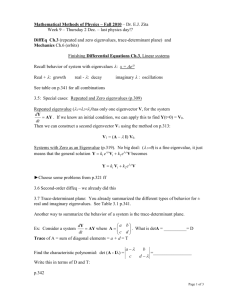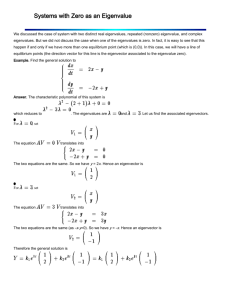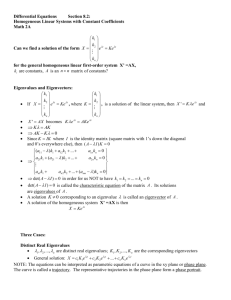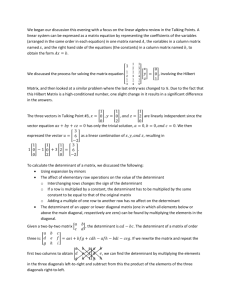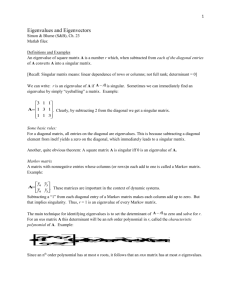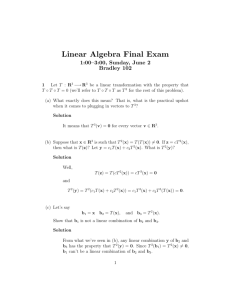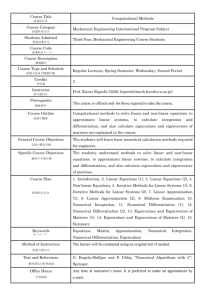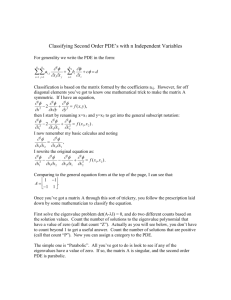Linear Algebra Quiz: Matrices, Eigenvalues, and Diagonalization
advertisement
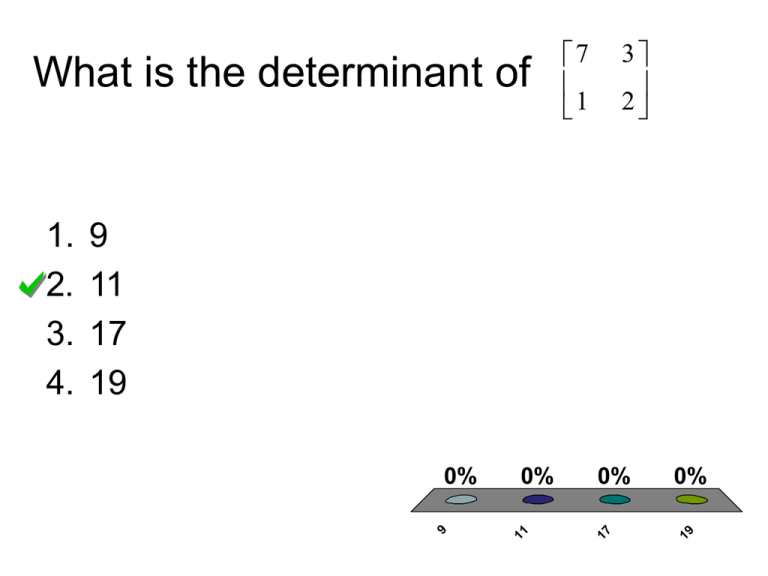
What is the determinant of 3 2 9 11 17 19 0% 19 0% 17 0% 11 0% 9 1. 2. 3. 4. 7 1 What is the determinant of 2 4 3 0 2 0 0 28 44 -28 0% -2 8 0% 44 0% 28 0% 0 1. 2. 3. 4. 6 1 2 Which matrix represents the following system of equations? x=4 y=7 1. 1 1 4 7 2. 1 11 1 3. 0% 0% 0% 3 1 4 7 2 0 1 1 0 What is the solution to the following system of equations? x 1 + x2 = 3 2x1 - 6x2 = -10 s. .. e e er e ar ar Th 0% no an x2 =½ Th an d =1 0% i.. . 0% er e x2 =2 0% an d x2 =5 =1 x1 x1 =4 an =9/ 8 0% an d d x2 ... 0% x1 x1=-9/8 and x2=-30/8 x1=4 and x2=5 x1=1 and x2=2 x1=1 and x2=½ There are an infinite number of solutions 6. There are no solutions x1 1. 2. 3. 4. 5. What is the solution to the following system of equations? 6x1 + 9x2 = 3 2x1 + 3x2 = 5 an d =1 x1 0% 0% 0% 0% x2 ==1. 5/ .. 2 an d Th x2 er ... e ar e Th an er i.. e . ar e no s. .. /.. . 0% x2 =1 an d =0 x1 =2 an d x2 =0 0% x1 x1=2 and x2=0 x1=0 and x2=1/3 x1=1 and x2=-1/3 x1=-5/2 and x2=2 There are an infinite number of solutions 6. There are no solutions x1 1. 2. 3. 4. 5. Which of the following statements are true? (A) sum of eigenvalues = sum diagonal elements (trace) (B) product of eigenvalues = determinant of square matrix A (C) distinct eigenvalues = linearly dependent eigenvectors 0% (A ), (B )a nd (.. . (.. . 0% nd (.. . (B )a nd B B 0% ot h (A )a nd (.. . 0% ot h (A )a nl y ot h O B nl y O 0% (C ) 0% (B ) (A ) 0% nl y Only (A) Only (B) Only (C) Both (A) and (B) Both (A) and (C) Both (B) and (C) (A), (B) and (C) O 1. 2. 3. 4. 5. 6. 7. Which of the following statements is true? 1. A -1 has an eigenvalue 1 2. (A - k) has an eigenvalue 3. (A - kI) -1 has an eigenvalue 1 4. 0% 4 0% 3 0% 2 0% 1 None of the above are true Dominant eigenvalue = eigenvalue with largest magnitude 1. True 2. False 3. Don’t Know 0% ’t Kn o ls e w 0% D on Fa Tr ue 0% What is the characteristic equation of the following matrix? 6 4 1. 2. 3. 4. λ² - 7λ + 6 = 0 λ² - 7λ + 14 = 0 λ² - 7λ - 2 = 0 None of the above 2 1 What are the eigenvalues of 4 0 2 and 4 0 and 4 0 and 2 6 and 8 6 an d 8 0% 2 an d 0 an d 0 an d 0% 4 0% 4 0% 2 1. 2. 3. 4. 0 2 What are the eigenvalues of the following matrix? 8 2 1. 2. 3. 4. λ = 2, 4 λ = 2, 6 λ = 2, 8 λ = 4, 8 4 2 What are the eigenvalues for the following matrix? 0 5 5 1. 2. 3. 4. λ = -5, 0, 5 λ = -5, 5, 10 λ = 0, 5, 5 λ = 5, 5, 10 5 5 0 5 0 5 What are the eigenvalues for the following matrix? 3 0 15 1. 2. 3. 4. λ = -2, 3, 4 λ = -6, -2, 3 λ = -2, 3, 6 λ = -6, -3, 2 0 3 5 1 0 1 Matrix A given below has eigenvalues λ = 2, 4, 6. Without further calculation -1 write down the eigenvalues for A . 3 A 1 0 1. 1 3 0 1 1 0 1, 2 , 3 2. 1 4. 0% 0% 0% 4 0% 3 1 1 1 , , 2 4 6 2 1 2 , ,1 3 3 3 1 3. , 1, 1 Which of the vectors below is an eigenvector, corresponding to the eigenvalue λ= 7 of the matrix 3 4 1. 4. 0% 0% 0% 0% 4 1 2 3 2 1 1 2 2 3. 2. 1 2 1 2 5 Which of the vectors below is an eigenvector, corresponding to the eigenvalue λ= 3 of the matrix 1 0 1 1. 2. 2 1 0 1 2 0 0% 0% 0% 0% 4 4. 3 1 2 0 2 2 3. 3 2 1 4 1 2 1 0 4 What are the eigenvectors of the following matrix? 5 5 1 1 1. 1 1 , 1 5 2. 3. 1 1 , 1 5 1 1 , 1 5 4. 0% 4 0% 3 0% 2 0% 1 1 5 , 1 1 Which of the following shows the eigenvectors for matrix A? 2. 0 3 1, 1 0 0 4. 0 3 1 1, 1, 1 0 0 0 0% 0% 0% 0% 4 0 3 1 1, 1 , 1 0 0 0 0 3 3. 1 1 0 2 2 0 3 1, 1 0 0 0 1 1. 2 A 1 0 Which set of vectors is linearly independent? 0% se th e ot h B on e of of th e ,2 ), (3 , ab ... ... 0% 4) 0% (1 ,6 ), (3 , 18 ) 0% N (1,6), (3,18) (1,2), (3,4) None of the above Both of the sets (1 1. 2. 3. 4. 1 2 3 1 3 4. 2 6 4 2 2 2 0% 0% 0% 0% 4 3. 3 8 1 2 1 2 2 3 3 2 2 1 2 2. 2 1. Normalise the eigenvector X. 1 3 X 2 1 Diagonalization means which of the following? 0% 0% ab ... a. .. th e of e on sf or m in g N M ul tip ly in g th . .. di a. th e in g dd A 0% .. 0% Tr an 1. Adding the diagonal elements of a matrix. 2. Multiplying the diagonal elements of a matrix. 3. Transforming a non-diagonal matrix. 4. None of the above. Why might we want to diagonalize a matrix? ... e th es th e fin d of e on N ot h of to sy Ea 0% ... 0% se e. w e. .. po tin g om pu C 0% .. 0% B 1. Computing powers of the matrix becomes easy. 2. Easy to find eigenvalues of a diagonal matrix. 3. Both of these reasons. 4. None of these reasons You can always diagonalize an n x n matrix with n distinct eigenvalues. 1. True 2. False 3. Don’t Know 0% ’t Kn o ls e w 0% D on Fa Tr ue 0% Below are eigenvectors of four 2x2 matrices. Which matrix is definitely diagonalizable? 1. 0 0 , 1 3 2. 1 0 , 0 3 3. 1 1 , 3 3 4. 0% 4 0% 3 0% 2 0% 1 1 3 , 1 3 1 A 1 0 . 2 Obtain the modal matrix P. 1. 1 1 0 1 2. 1 1 0 1 3. 4. 0% 0% 0% 0% 4 4 1 3 1 1 2 4 1 1 3 1 The matrix A= 1 0 3 2 has eigenvalues 1 and 2 with respective eigenvectors - If 1. calculate 1 P1 AP1 . 2. 4 2 3. 1 0 2 2 4. 0 2 0% 0% 0% 0% 4 1 0 3 4 2 2 1 0 1 1 1 1 1 1 P1 0 1 1 and 0 1 2 A 4 3 5 What is A²? 1. 4 16 4. 13 23 23 41 0% 0% 0% 0% 4 21 37 9 25 3 3. 16 28 2. 2 6 10 1 4 8 2 A 4 3 5 What is A ? 5 1. 243 3125 8097 14237 4. 10796 6140 14237 80972 0% 0% 0% 0% 4 6140 10796 32 1024 3 3. 2. 2 15 25 1 10 20 The eigenvalues of a symmetric matrix with real elements are... 1. Always complex 2. Always real 3. Either complex or real rc th e Ei A lw ay s om pl ex re a m pl ex co s ay lw A 0% ... 0% l 0% Which of the following is a symmetric matrix? 1. 1 5 2 5 3 7 2 7 2 2. 7 4. 4 1 6 3 0% 0% 0% 0% 4 3 3 7 4 3 2 2 1 2 3 4 1 1 3. 1 4 A square matrix A is said to be orthogonal if A -1 A T 1. True 2. False 3. Don’t Know no w 0% Do n’ tK se 0% Fa l Tr ue 0% Two n x 1 column vectors X and Y are orthogonal if XY=0 1. True 2. False 3. Don’t Know 0% ’t Kn o ls e w 0% D on Fa Tr ue 0% The eigenvalues of a symmetric matrix A are λ=0 and λ=10 9 A 3 3 1 X and Y are the eigenvectors for λ=0 and λ=10 respectively. Are X and Y orthogonal? 1. Yes 2. No 3. Don’t Know no w 0% Do n’ tK 0% No Ye s 0% An Hermitian matrix is one satisfying A A T 1. True 2. False 3. Don’t Know no w 0% Do n’ tK se 0% Fa l Tr ue 0% Is the following matrix Hermitian? 2i 3 i 3 A 2i 0 1 3 i 1 5 1. Yes 2. No 3. Don’t Know 0% w o 0% D on ’t Kn o N Ye s 0% s 2 s Separating the variables in gives 1. s ( t ) Ae 2t 2. s ( t ) 2 Ae 2 s 3. 2t 0% 0% 0% 4 0% 3 s ( t ) Ae 2t 2 4. 1 s ( t ) 2 Ae Write in matrix form the pair of coupled differential equations x 2 x 3 y y 5 x y 1. 5 x 1 y x 2 y 3 3. 5 x 1 y 3 x 1 y 3 x 1 y 0% 0% 0% 4 x 2 y 5 0% 3 4. 2 x 2 y 5 2. 1 x 2 y 3 Find the solution of the coupled differential equations x x 4 y y 3 y with initial conditions x(0)=1 and y(0)=3 1. x (t ) 2 e t y (t ) 3e 3t 3e 3t 2. x (t ) 2 e y (t ) 3e 3. t 4. x (t ) 2 e 3e t y (t ) 3e t t 0% 0% 0% 0% 4 t 3t 3 y (t ) 3e 3t 2 t 3e 1 x (t ) 2 e 3e t 2 Given r 1 r 1 r . What is the general solution to a system of 2nd order differential equations for the negative eigenvalues 1 , 2 ? 1. r (K L)cos 1 t s ( M N)sin 2 t 2. r Kcos 1 t Lsin 1 t s Mcos 2 t Nsin 2 t r Kcos 1 t Lsin 2 t s Mcos 1 t Nsin 2 t r K(cos 1 t sin 1 t) 0% 0% 0% 0% 4 3 s M(cos 2 t sin 2 t) 2 4. 1 3. An elastic membrane in the x1 x 2 plane 2 2 with boundary circle x1 x 2 1 is shown below. The membrane is stretched so the point P:(x1 , x 2 ) goes over the point Q:( y 1 , y 2 ) where y1 7 y Ax 4 y2 4 x1 7 x2 Find the amount that the principle directions are stretched by ’t K no D on 7 ct or s fa y 0% w .. a. .. 0% a. ct or s 4 a. fa y B B y fa ct or s 7 a. 3 ct or s fa y 0% .. 0% .. 0% B By factors 3 and 11. By factors 7 and 4. By factors 4 and 4. By factors 7 and 7. Don’t Know B 1. 2. 3. 4. 5.




